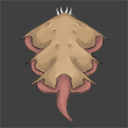So what is the work I've been doing? I've actually not been animating, well a little bit but mostly correcting small errors in the animation. For example adding the teeth and merging the line art layer for clean up, where ever the "fleshy" part of the alien would clip through.
Other than that it's been work, moving the entire previous animation I did in Photoshop CC's video layer tool over to the key frame tool. This meant sitting down for a good while cutting and pasting each individual part, and frames of the alien over to a new document using the key frame animation instead.
The reason for this, has been explained in the previous post. It's basically video layers not working too well when you want to duplicate an animation and re-use it, only mirrored and editable.
When I was finished transferring the animation over to key frame animation, I started setting up the layers so the animation could actually play. This is a very time consuming process, since every layer will be representing each frame ( work flow with key frames explained in the first artifact post ).
After all the "hard" work was over I began filling in the flats for the alien, through out the frames.
I did feel like the colors I picked from the first iteration of the alien was a tad too saturated. So I'm experimenting with the hue/saturation in order to hit the sweet spot for the color scheme.

Sorry for the flashing, but I have only finished a few frames completely. Shading an animation takes a bit of time. Speaking of shading, it's another part of the animation I've learned a lot about. The work flow I used for the very first version was to hand paint everything at a high resolution.
Each frames was a "finished" frame. This was not optimal. Because every frame I finished had way more differences compared to the neighboring frame. you could compare it to working zoomed in on a painting for too long and not seeing the whole picture.
What I've been doing differently this time around is that I'm rendering 2 frames completely and then use those 2 frames as a reference point. After that I'll shade in one shadow at a time, and then do a playback to see if that single shadow fits into the animation.

Hello Lucas! Time to deliver you some feedback for this weeks post!
ReplyDeleteYour overall effort for these animations are very, very good! I can't help but be jealous of your painting skills!
It's clear to me you spend a lot of time with each individual artifact and the fact that you notice your own problems, to me is incredibly impressive, and is something I struggle with personally very much.
The only real problem I have with this post, in general (not the content) is the fact that it relates to the previous posts, considering the fact that I don't even know what game you are doing. It's something that I've not done properly either in my posts. It's annoying, but such a small thing as well.
Your work with saturation and colors is very tangible and cool too.
Towards the end of your post, it becomes very unclear to me what exactly is going on during your talk of frames. If I were you I would try to clarify exactly what you were doing and explain it more pinpointed terms. I don't quite understand what your talk of "finished frame" that weren't "optimal" was about.
Hopefully you get a chance to adress this in the near future! Good job!
//William